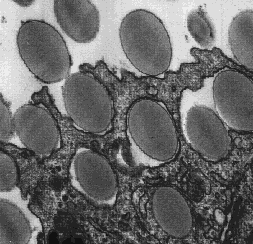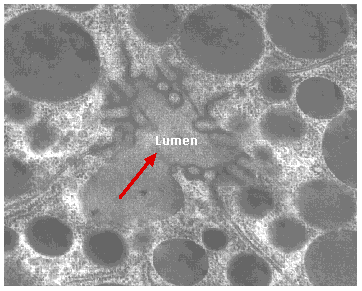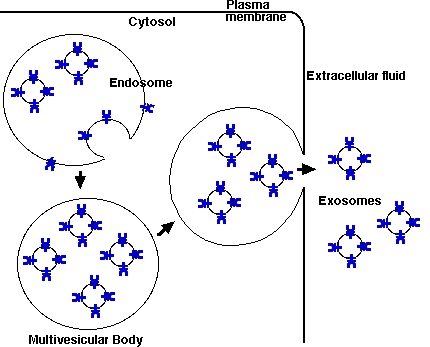
Exocytosis is the reverse of endocytosis.
And that is just as well. In 30 minutes an active cell like a macrophage (right) can endocytose an amount of plasma membrane equal to its complete plasma membrane.
This electron micrograph (courtesy of Dr. Robert J. North) shows a guinea pig phagocyte ingesting polystyrene beads. Several beads are already enclosed in vacuoles while the others are in the process of being engulfed.
So the cell must have a mechanism to restore the normal amount of plasma membrane. Exocytosis is that mechanism.
Membrane-enclosed vesicles move to the cell surface where they fuse with the plasma membrane. This accomplishes three things:

Exocytic vesicles are created from several sources:
Some cells specialize in secretion. In cells that secrete large amounts of protein, for example, the protein accumulates in specialized secretory granules formed by the Golgi apparatus. These move to the cell surface and discharge their contents to the outside.

Examples:
(* originally published in Fawcett, The Cell: Its Organelles and Inclusions, W. B. Saunders Co., 1966.)
The process described above involves the fusion of the exocytotic vesicle with the plasma membrane.
In some cells, such as at synapses, a second type of exocytosis also takes place:This "kiss-and-run" version of exocytosis does not restore plasma membrane to the cell.

Still a third type of exocytosis is found in some cells.
This involves endosomes themselves invaginating their membrane. As the invaginations break off they produce vesicles within vesicles, called multivesicular bodies.
When these fuse with the cell's plasma membrane, these tiny (40–100 nm) internal vesicles — called exosomes — are secreted.
Exosomes are produced in abundance by dendritic cells and B-cells and enhance their antigen-presenting function.
| Welcome&Next Search |